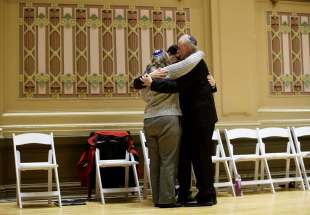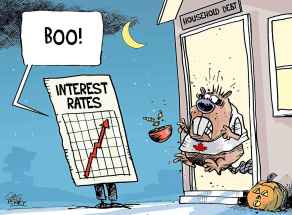Halloween is among our strangest celebrations, yet one of our more cathartic People’s attraction to gruesomeness reflects our irrational, thrill-seeking nature, psychologists believe
Read this article for free:
or
Already have an account? Log in here »
To continue reading, please subscribe:
Monthly Digital Subscription
$0 for the first 4 weeks*
- Enjoy unlimited reading on winnipegfreepress.com
- Read the E-Edition, our digital replica newspaper
- Access News Break, our award-winning app
- Play interactive puzzles
*No charge for 4 weeks then price increases to the regular rate of $19.00 plus GST every four weeks. Offer available to new and qualified returning subscribers only. Cancel any time.
Monthly Digital Subscription
$4.75/week*
- Enjoy unlimited reading on winnipegfreepress.com
- Read the E-Edition, our digital replica newspaper
- Access News Break, our award-winning app
- Play interactive puzzles
*Billed as $19 plus GST every four weeks. Cancel any time.
To continue reading, please subscribe:
Add Free Press access to your Brandon Sun subscription for only an additional
$1 for the first 4 weeks*
*Your next subscription payment will increase by $1.00 and you will be charged $16.99 plus GST for four weeks. After four weeks, your payment will increase to $23.99 plus GST every four weeks.
Read unlimited articles for free today:
or
Already have an account? Log in here »
Hey there, time traveller!
This article was published 29/10/2018 (2601 days ago), so information in it may no longer be current.
Ghoul, goblins, ghosts and gore: these are the truly bizarre hallmarks of the season.
Halloween is among children’s favourite times of year — for good reason. Wearing costumes and collecting candy make for a potently intoxicating, albeit benign, mix.
Yet many folks might wonder for what purpose we celebrate the macabre.

Are we, despite our layers of civility, sick little monkeys deep down?
And does this celebration of dreadful thumps in the long night serve some socio-psychological purpose?
Yes and yes: Halloween is very much a product of the human condition and all the messiness it entails, according to two psychologists who have written about the subject for Psychology Today.
On one hand, the celebration helps us grapple with monstrous elements of the real world and, on the other, with repressed monsters buried deep inside.
Indeed, its gruesomeness, and many people’s attraction to that ghastliness, reflect our irrational, thrill-seeking nature, says Dr. Stuart Vyse, psychologist and author of Believing in Magic: The Psychology of Superstition.
“When you think about Halloween the movie… for example, there is good evidence that for lots of people, there is a thrill involved in being scared in a circumstance they know is contained.”
Of course, thrill-seeking is a matter of personal taste. Some people are drawn to skydiving, even though they may not like watching horror films.
“But I would not do it (jump out of a plane) if someone paid me,” says Vyse, a retired professor at Connecticut College, and contributing editor for Skeptical Inquirer magazine.
“Yet I love a scary movie.”
Of course, many children don’t watch horror movies, let alone jump out of planes.
But the fascination with fear and revelling in dressing up provide a release regardless of age, says Dr. Andrea Polard, a Los Angeles-based psychologist and author of A Unified Theory of Happiness.
“Human beings can be like wild animals,” she says. “We can hurt each other, and murder each other… in the dark.”
Certainly, the news headlines point to human beings having a capacity for doing bad things.
“We have — even though we’re so civilized and controlled— these dark sides,” Polard says.
“It’s just swept under the carpet.”

That’s not to say we’re bad hombres, she adds. But we do live in a highly structured society that demands we repress our impulses… most of the time.
So in this context, Halloween serves as a safe and healthy release for the young, and the young at heart.
By the same token, Halloween is and always has been a means for many northern hemisphere dwellers to grapple with harsh realities.
It originates from Celtic society, which several centuries ago was agrarian and dependent on a good harvest to last through the winter.
“You had to deal with what you had, and it would largely determine your survival,” Polard says, adding that people of that era faced illness and death with much higher frequency than today, especially during the cold and dark months. Moreover they tended to believe bad spirits were the cause of illness and death.
And Samhain — the Gaelic term for the end of harvest celebration — not only marked the start of the dark half of the year. It also was a time when spirits could easily cross from their world to ours.
“People were afraid these spirits would play dangerous and deadly tricks, so they would put offerings outside their house so the spirits wouldn’t come inside,” Polard says, adding this speaks to today’s tradition of costumed children shouting “trick or treat” at your doorstep.
Yet the event was by no means bleak. It was a celebration that helped people deal with unpleasant aspects of life.
Over time, Christianity influenced the tradition.
And along with it other fears and superstitions bubbled to the surface, for better and for worse, Vyse notes.
“Our main strength as a species is our ability to adapt and learn from our environment at a very good rate,” he says. Superstitions are a way to manipulate what we otherwise deem uncontrollable, like a pair of lucky socks.
“That’s you making an association,” Vyse says of the comparison. “It’s not a real one, but we are very much as a species built around trying to find those connections” because we find comfort in them.
That said, the most widely held superstitions are learned behaviours, leading one to question whether they serve any benefit.
“If no one had taught us black cats are unlucky, it’s unlikely we would make that association,” Vyse says.

Moreover, Halloween and much of its imagery, such as witchcraft, points to “our long history of superstition being a label we use (derisively) to refer to someone else’s religion.”
This partly explains why the Catholic church, and some Protestant sects, accused individuals engaging in pagan rites and rituals of being “witches consorting with the demons,” he says.
Witchcraft and devil worship aside, pagan traditions on a more practical level posed a threat to Christian rule.
As such, Samhain was eventually appropriated, becoming a Christian holiday — All Hallows’ (Saints) Eve. This evolution also illustrates how Halloween is a sign of the times. That’s why today one could argue Halloween is as much a marketing opportunity as it is a celebration. We consumers are bombarded with messaging to buy candy, costumes and decor as a way to celebrate.
Yet this time of year is not festive for everyone.
“We don’t decorate for Halloween, Christmas or Easter or any of those holiday times, because for certain people it can be very triggering,” says Tara Brousseau Snider, executive director of the Mood Disorders Association of Manitoba.”
Halloween’s grisly imagery can be particularly difficult for individuals with anxiety, depression, post-traumatic stress disorder and psychosis.
“It marks a very dismal time of year,” she says, adding mental illness symptoms can flare up as the days get shorter. “It’s not about bunnies and flowers.”
Regardless, Halloween is a celebration that’s likely to remain relevant because of its social and psychological utility — a chance for kids and adults to play with and in turn placate their fears.
“It’s holiday where you can age-appropriately” deal with unpleasant truths, Polard says.
“You need to let your kid (or inner child) experience a little bit of that, and … only you know how much your child can take.”









